
|
Astronomy Picture Of the Day (APOD)
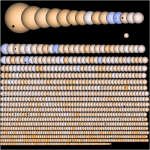 Kepler s Suns and Planets
Kepler s Suns and Planets
29.03.2011
Using the prolific planet hunting Kepler spacecraft, astronomers have discovered 1,235 candidate planets orbiting other suns since the Kepler mission's search for Earth-like worlds began in 2009. To find them, Kepler monitors...
 Time Lapse Auroras Over Norway
Time Lapse Auroras Over Norway
28.03.2011
Sometimes, after your eyes adapt to the dark, a spectacular sky appears. Such was the case earlier this month when one of the largest auroral displays in recent years appeared over northern locations like the border between Norway and Russia.
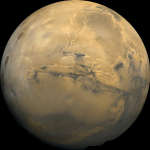 Valles Marineris: The Grand Canyon of Mars
Valles Marineris: The Grand Canyon of Mars
26.03.2011
The largest canyon in the Solar System cuts a wide swath across the face of Mars. Named Valles Marineris, the grand valley extends over 3,000 kilometers long, spans as much as 600 kilometers across, and delves as much as 8 kilometers deep.
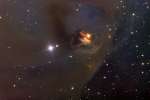 T Tauri and Hind s Variable Nebula
T Tauri and Hind s Variable Nebula
25.03.2011
The yellowish star near center in this remarkable telescopic skyview is T Tauri, prototype of the class of T Tauri variable stars. Nearby it is a dusty yellow cosmic cloud historically known as Hind's Variable Nebula (NGC 1555).
 Auroral Substorm over Yellowknife
Auroral Substorm over Yellowknife
24.03.2011
Intense auroral activity flooded the night with shimmering colors on February 24, captured here from a lodge near the city of Yellowknife in northern Canada. The stunning sequence (left to right) of three all-sky exposures, taken at 30 second intervals, shows rapid changes in dancing curtains of northern lights against a starry background.
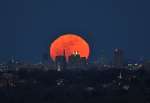 Boston Moonrise
Boston Moonrise
23.03.2011
Last week's Full Moon was hard to miss. Rising on March 19, its exact full phase occurred within an hour of perigee, the closest point in the Moon's orbit to Earth.
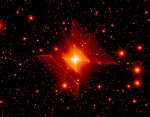 MWC 922: The Red Square Nebula
MWC 922: The Red Square Nebula
22.03.2011
What could cause a nebula to appear square? No one is quite sure. The hot star system known as MWC 922, however, appears to be embedded in a nebula with just such a shape. The above image combines infrared exposures from the Hale Telescope on Mt.
 NGC 6384: Spiral Beyond the Stars
NGC 6384: Spiral Beyond the Stars
21.03.2011
The universe is filled with galaxies. But to see them astronomers must look out beyond the stars of our galaxy, the Milky Way. For example, consider this colorful telescopic view of spiral galaxy NGC 6384, about 80 million light-years away in the direction of the constellation Ophiuchus.
 The CMB Cold Spot
The CMB Cold Spot
20.03.2011
How could part of the early universe be so cold? No one is sure, and many astronomers now think that the CMB Cold Spot on the cosmic microwave background (CMB) radiation is not particularly noteworthy. As the early universe expanded and cooled, it suddenly and predictably became transparent.
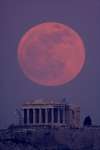 Parthenon Moon
Parthenon Moon
19.03.2011
Did you see the Full Moon last night? Near the horizon, the lunar orb may have seemed to loom large, swollen in appearance by the famous Moon illusion. But the Full Moon really...
|
January February March April May June July August September October November December |
|||||||||||||||||||||||||||||||||||||||||||||||||